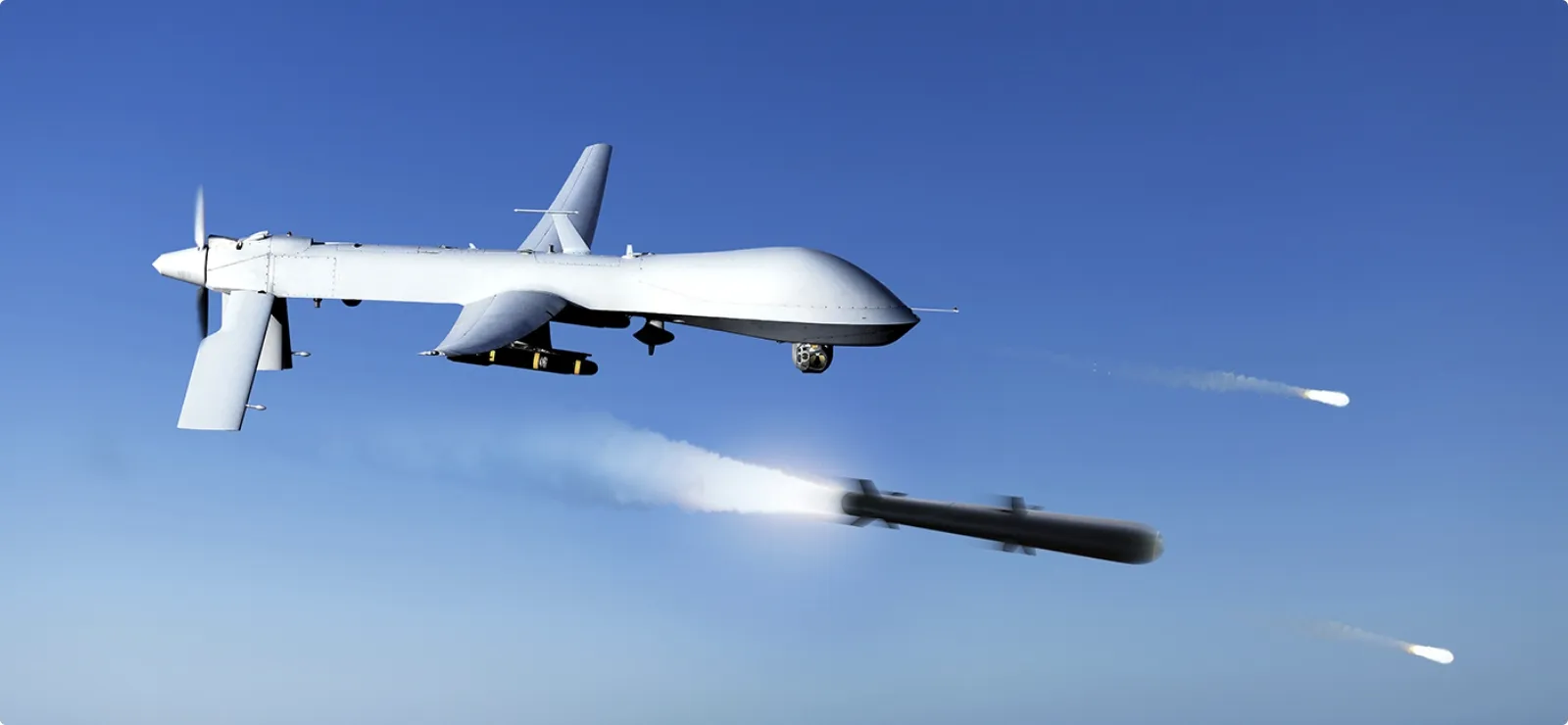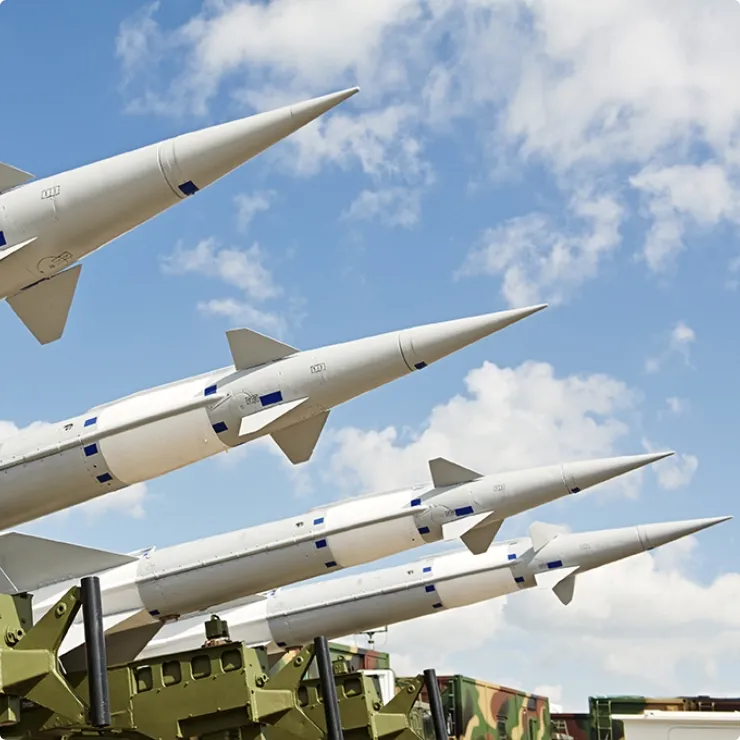
In a world riddled with volatility, political shifts and conflicts often create unpredictable challenges across regions and nations. In such a scenario, advanced defense technology plays a crucial role in maintaining stability by supporting preparedness and resilience. As a leading provider of planning and optimization solutions, ICRON is uniquely equipped to support the defense industry by elevating the productivity and efficiency of operations.
Groundbreaking innovations and advanced missile systems are transforming the global defense industry. Manufacturers navigate significant challenges, including rapidly changing geopolitical landscapes, stringent regulations, and the need to effectively cater to diverse international markets. ICRON solutions have helped enhance capacity planning and scheduling capabilities for advanced production processes in the defense manufacturing industry. With ICRON Production & Capacity Planning and Production Scheduling, our client attained a 25% decrease in additional resource requirements and increased the OTIF ratio by 10% over the course of this partnership. These improvements have significantly enhanced our client’s business growth and profitability.
Defense technology is built on the belief that science is the strength of nations. The organization is devoted to researching, engineering, and supporting technology that delivers military capability, protects national security, and instills confidence in a nation’s defense forces. As a leading defense manufacturer, their work advances scientific discovery and provides innovative solutions that promote international stability by enhancing security.
As our client grows its global presence, its manufacturing processes have evolved in size and complexity. Defense manufacturing supply chains have a need for resilience that goes beyond operational efficiency and profitability. They aimed to deliver premium defense infrastructure for clients under any circumstances, even amid unprecedented disruptions. Working alongside the ICRON experts, they aimed to enhance its supply chain planning to match the scale and significance of its operations.
Here is a look at their principal goals in this story
Evolving customer demands and rapid market shifts prompted the defense manufacturer to reevaluate its capacity planning process. To achieve its goals, it aimed to enhance capacity planning and scheduling, moving beyond manual, experience-based approaches to address operational and material constraints.
Our client sought production scheduling solutions to optimize resource engagement across their supply chain. They aimed to deploy a dynamic scheduling process that optimizes resource utilization, ensures efficient production, and facilitates rapid adjustments during disruptions
Dealing with diverse constrained and unconstrained scenarios in defense manufacturing calls for effective decision-making at every level. The company’s most critical goal was to enhance decision intelligence for comprehensive supply chain visibility that streamlines production and aligns it with strategic business goals.
Enhancing Capacity Planning & Scheduling
Evolving customer demands and rapid market shifts prompted the defense manufacturer to reevaluate its capacity planning process. To achieve its goals, it aimed to enhance capacity planning and scheduling, moving beyond manual, experience-based approaches to address operational and material constraints.
Optimize Resource Utilization
Our client sought production scheduling solutions to optimize resource engagement across their supply chain. They aimed to deploy a dynamic scheduling process that optimizes resource utilization, ensures efficient production, and facilitates rapid adjustments during disruptions
Improved End-to-End Visibility
Dealing with diverse constrained and unconstrained scenarios in defense manufacturing calls for effective decision-making at every level. The company’s most critical goal was to enhance decision intelligence for comprehensive supply chain visibility that streamlines production and aligns it with strategic business goals.

The defense manufacturer needed to implement multi-objective production plans, and optimizing the allocation of stocks for customer orders at each bill of materials level was essential to increase efficiency.
Integrating production constraint data and lacking a practical scenario analysis limited the exploration of alternative solutions. There was also an inability to work quickly and easily in different scenarios according to changing priorities. The complexity of production, massive data volumes, and high bill of materials levels compounded these challenges.
Stock allocation rules contributed to high inventory levels, with constraints such as shelf life, service life, and dynamic lead times adding complexity. The complexity of material management, including substitute material usage and project-based inventory tracking, added to the challenges of optimizing inventory levels.
Balancing in-house and subcontracted production involved managing specific rules, including the length of subcontracting supply periods and transferring necessary materials and semi-finished products to subcontractors.
The complexity of production and long planning horizons made manual planning challenging. There was a failure to compensate for deviations in plan accuracy due to long material supply times and shelf-life constraints. Enhancing agility in responding to changing dynamics and compensating for deviations in plan accuracy caused by long material supply times and shelf-life constraints was crucial.
In a project-based manufacturing environment it was challenging to manage optimal capacity allocation and project prioritization jointly. Assessing the capacity requirements together with the delivery compliance for new and potential projects were also impossible. Long production and supply processes further complicated planning over a broad horizon.
Changes in geopolitical conditions lead to challenges in sourcing materials, managing lead times, and ensuring reliable delivery. Adapting to these uncertainties is critical for meeting global demand.
The defense industry operates under strict regulatory and technological demands. It must comply with complex standards while sourcing advanced materials and technologies. Ensuring reliability and innovation within these constraints is a persistent challenge.
Multi-Objective Planning Requirements
The defense manufacturer needed to implement multi-objective production plans, and optimizing the allocation of stocks for customer orders at each bill of materials level was essential to increase efficiency.
Data and Scenario Analysis Challenges
Integrating production constraint data and lacking a practical scenario analysis limited the exploration of alternative solutions. There was also an inability to work quickly and easily in different scenarios according to changing priorities. The complexity of production, massive data volumes, and high bill of materials levels compounded these challenges.
High Inventory Levels
Stock allocation rules contributed to high inventory levels, with constraints such as shelf life, service life, and dynamic lead times adding complexity. The complexity of material management, including substitute material usage and project-based inventory tracking, added to the challenges of optimizing inventory levels.
Subcontract Production Coordination
Balancing in-house and subcontracted production involved managing specific rules, including the length of subcontracting supply periods and transferring necessary materials and semi-finished products to subcontractors.
Manual Planning Complexity
The complexity of production and long planning horizons made manual planning challenging. There was a failure to compensate for deviations in plan accuracy due to long material supply times and shelf-life constraints. Enhancing agility in responding to changing dynamics and compensating for deviations in plan accuracy caused by long material supply times and shelf-life constraints was crucial.
Joint Capacity Management and Prioritization
In a project-based manufacturing environment it was challenging to manage optimal capacity allocation and project prioritization jointly. Assessing the capacity requirements together with the delivery compliance for new and potential projects were also impossible. Long production and supply processes further complicated planning over a broad horizon.
Rapid Geopolitical Changes
Changes in geopolitical conditions lead to challenges in sourcing materials, managing lead times, and ensuring reliable delivery. Adapting to these uncertainties is critical for meeting global demand.
Stringent Regulations
The defense industry operates under strict regulatory and technological demands. It must comply with complex standards while sourcing advanced materials and technologies. Ensuring reliability and innovation within these constraints is a persistent challenge.
Introduced multi-objective optimization with options for both constrained and unconstrained capacity planning. Incorporated stock allocation rules and aging mechanisms within optimization models and provided detailed material requirement reports for each customer order.
Impact assessment to identify supply chain dependencies, enhancing visibility into ATP (Available to Promise) and CTP (Capable to Promise) commitments. It helps determine the root cause of problems quickly and easily. Improved agility and resilience, enabling accurate demand fulfillment and rapid response to supply chain shifts.
The system introduced data validation and significantly improved data maturity levels, enabling advanced decision making capabilities. Enhanced scenario analysis enabled the simultaneous evaluation of multiple scenarios with different optimization options.
We developed capacity planning models without traditional capacity constraints, focusing solely on stock and procurement. This allowed for more flexible planning in situations where capacity was not the primary limitation.
Provided a four-year capacity investment outlook, essential for long-term investment decisions, offering visibility into required capacities and investment needs for project completion.
Delivered solutions to support two-year operational investment decisions, enabling better alignment of operational goals with available resources.
Improved subcontract production planning by integrating specific rules directly into the planning process, balancing in-house and subcontracted production through optimized scheduling.
Enabled our client to create an agile and dynamic production plan that could quickly adapt to changing conditions. Developing and comparing alternative scenarios allowed for informed decision-making and effective responses to different needs.
Enhanced inventory management by considering material constraints, which led to improved inventory levels, reduced waste, and better material utilization. Balanced internal and external capacity management ensured efficient use of resources, minimizing bottlenecks and optimizing production.
Supported capacity requirement analysis over four years, providing critical insights for informed investment decisions. Facilitated strategic resource investments by aligning capacity needs with future growth opportunities.
Ensured accuracy and consistency in planning, improving reliability and execution across production activities. Enabled proactive decision-making with increased master data accuracy, end-to-end visibility, critical path, and reasoning analysis.
Enabled visibility, providing end-to-end analysis and tracking throughout the supply chain, which improved transparency and coordination. Easy bottleneck resource or material analysis helped identify potential issues and streamline operations.
Facilitated scenario comparisons to determine the best possible outcomes. Provided the ability to conduct what-if analysis for customer orders, supporting proactive planning and better response to market demands.
Enabled project unsatisfaction reason analysis and critical path tracking, empowering the manufacturer to understand challenges better and take corrective actions. Improved efficiency by identifying and addressing bottlenecks in resources or materials.
Empowered our client to run proactive decision mechanisms, leveraging end-to-end visibility, critical path, and reasoning analysis to anticipate and address challenges effectively.

OTIF ratio by 10%.
Capacity utilization by 10%.
Compliance with confirmations by 20%
Planning accuracy 20%.
Operational costs by 10%.
Inefficiency in the planning process by 5%.
Inventory levels by 5%.
Additional resource requirement by 25%.
Overtime by 30%.
OTIF ratio by 10%.
Capacity utilization by 10%.
Compliance with confirmations by 20%
Planning accuracy 20%.
Operational costs by 10%.
Inefficiency in the planning process by 5%.
Inventory levels by 5%.
Additional resource requirement by 25%.
Overtime by 30%.
ICRON Demand empowers businesses to navigate uncertainty through accurate forecasting using AI-driven methods that take into consideration historical data, reaTime updates, and fast adaptation to changing market conditions and disruptions.
READ MORE